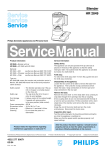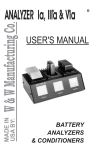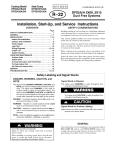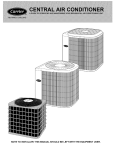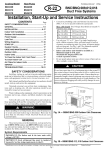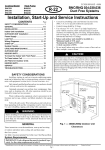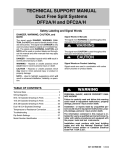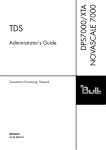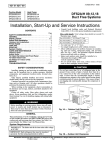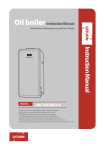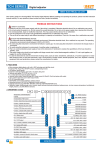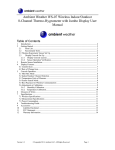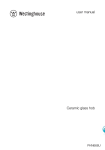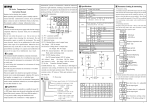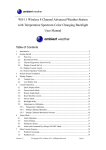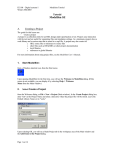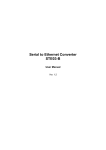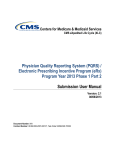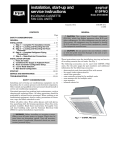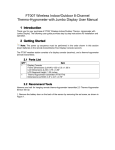Download Installation, Start-Up and Service Instructions
Transcript
Coolinq
Model
Heat Pump
BCC018
BCQ018
BCC024
BCQ024
51302618918-C
0606
BCC/BCQ 018, 024
Duct Free Systems
Installation, Start-Up and Service Instructions
CONTENTS
SAFETY CONSIDERATIONS
GENERAL ...........................................................
INSTALLATION
Consult local building codes and National Electrical Code
(NEC, U.S.A.) for special installation requirements.
Page
................................
1
1-6
................................................
Max. cable length. Total voltage drop should not exceed 1V.
Therefore max. length:
6-13
........................................
6
For #18 AWG
24.3 Feet (7.4 m)
.....................................
8
For #16 AWG
37.7 Feet (11.5 m)
Power Supply .......................................................
Leak Test ...............................................................
9
9
For #14 AWG
50.0 Feet (18 m)
Indoor
Unit Installation
Outdoor
Unit Installation
Use only type "G" or "C" fuses. Use single length power
cable without extension. Allow sufficient space for airflow
clearance on condensing units for wiring, refrigerant piping,
and servicing unit. See Fig. 1 and 2 for minimum required
distances between unit and walls or ceilings.
Indoor and outdoor units should be installed at a
Minimum length of 10 ft. apart.
Maximum line length of 50 ft. and
vertical separation of 30 ft.
Do not install indoor units near a direct source of heat such as
direct sunlight, steam or flame.
Wiring Diagrams ............................................
11-12
START-U P ...........................................................
13
System Checks ...................................................
CARE AND MAINTENANCE ...............................
13
13
Outdoor Units .....................................................
13
Indoor Units ........................................................
13
To Clean the Indoor Unit Front Panel ............... 13
To Clean Indoor Coil ..........................................
13
Air Filters for Indoor Units ................................
13
SERVICE .............................................................
13
TROUBLESHOOTING
....................................
14-17
SAFETY CONSIDERATIONS
Installing, starting up, and servicing air-conditioning equipment can be hazardous due to system pressures, electrical components, and equipment location (root;, elevated structures, etc.).
Only trained, qualified installers and selaTicemechanics should
install, start-up, and service this equipment.
Do not bury more than 36 in. of refrigerant pipe in the _ound. If
any section of pipe is buried, there must be a 6 in. vertical rise to
the valve connections on the outdoor units. If more than the recomlnended length is buried, refrigerant may mira'ate to the cooler
buried section during extended periods of systeln shutdown. This
causes refiiger-ant slugging and could possibly damage the compressor at start-up.
Untrained personnel can perform basic maintenance functions such as cleaning coils. All other operations should be performed by trained service personnel.
When working on the equipment, observe precautions in the
literature and on tags, stickers, and labels attached to the equipment.
Follow all safety codes. Wear safety glasses and work gloves.
Keep quenching cloth and fire extinmaisher nearby when brazing.
Use care in handling, rigging, and setting bulky equipment.
Before installing or servicing system, always turn offmain power
to system and install lockout tag on disconnect. There may be
more than one disconnect switch. Electrical shock can cause
personal injury.
GENERAL
These instructions cover the installation, start-up and sela_icing of 38BCC/BCQ outdoor and 40BNC/BNQ indoor units cooling only and heat pump duct free systems. See Table 1 for parts
included. See Tables 2 and 3 t\_r Physical Data.
System
Requirements
IMPORTANT: The Indoor
voltage is 30 VDC.
units & the inter units cable
IMPORTANT:
Each refrigerant
line must be insulated
Separately. See line sizing requirements in tabel 2.
Fig. 1 -- 38BCC/BCQ 018, 024 Outdoor Unit Clearances
Manufacturer reserves the right to discontinne, or change at an} time, specifications
Pg 1
or designs without notice and without inc
Printed in Israel
Table 1 m Parts List m High Wall Units
ITEM
QTY
Mounting Bracket
2X1
DIAGRAM
40BNC/BNQ 009,012
Long Screws
2X8
Outdoor Sensor
Connecting Cable
2X1
(Available for HEAT PUMP ONLY)
Absorption Cushions
4
Electric Terminals
2X8
2X
Remote Controller
1 Mounting
Mounting Bracket
Bracket with 2 screws
Remote Controller
2X1
and Batteries
Insulation for indoor Fittings
2X1
Owner's Manual
2X1
1
Wall mounted Receiver RTX
(OPTIONAL)
(Not included)
2
Table 2 - Physical Data - Cooling
INDOOR UNIT
Only
2 X 40BNC009
2 X 40BNC012
2 X 9,000
13.0
2 X 11,400
13.0
SYSTEM CHARGE (Ib)*
2 X 2.4
2 X 3.1
MOISTURE REMOVAL (pt/hr)
2 X 2.6
2 X 4.5
AIRFLOW (3 Speeds)
High / Med. / Low Cfm
2 X 350 / 2 X 280 / 2 X 220
2 X 370 / 2 X 280 / 2 X 220
DIMENSIONS LxHxW (in.)
32 3/32x10 15/64x7 9/32
32 3/32x10 15/64x7 9/32
R-22
R-22
2 X 19.0
2 X 19.0
38BCC018
38BCC024
30/30/50
30/30/50
1/4...1/2
1/4...1/2
Panasonic-2R13S 126A6F
Panasonic-2P17SR126B 1A
35.5 X 49.5 X 12.6
35.5 X 49.5 X 12.6
NET WEIGHT (Ib)
226
228
METERING TYPE
Piston (Accurator)
Piston (Accurator)
COOLING CAPACITY (Btuh)
SEER
REFRIGERANT TYPE
NETWEtGHT
OUTDOOR
(Ib)
UNIT
TUBE CONNECTIONS
Vert Lift/Vert Drop/Max Length (ft)
NOMINAL LINE SIZING
Mixed Phase...Suction
COMPRESSOR TYPE
DIMENSIONS
(in.)
LxHxW(in.)
LEGEND
Accurator is non-serviceable
SEER -- Seasonal Energy Efficiency Ratio
*Units are shipped with a factory charge based on 25 ft of refrigerant lines.
Table 3 - Physical Data - Heat Pump
INDOOR UNIT
2 X 40BNQ009
2 X 40BNQ012
COOLING CAPACITY (Btuh)
SEER
2 X 9,000
13.0
2 X 11,400
13.0
HEATING CAPACITY (Btuh)
HSPF
17,200
7.7
23,600
7.7
SYSTEM CHARGE* (Ib)
2 X 2.4
2 X 3.1
MOISTURE REMOVAL (pt/hr)
2 X 2.6
2 X 4.5
AIRFLOW (3 Speeds)
High / Med. / Low Cfm
2 X 350 / 2 X 280 / 2 X 220
2 X 370 / 2 X 280 / 2 X 220
DIMENSIONS LxHxW (in.)
32 3/32x10 15/64x7 9/32
32 3/32x10 15/64x7 9/32
R-22
R-22
2 X 19.0
2 X 19.0
38BCQ018
38BCQ024
30/30/50
30/30/50
1/4...1/2
1/4...1/2
Panasonic-2R13S126A6F
Panasonic-2P17SR126B1A
REFRIGERANT TYPE
NET WEIGHT (Ib)
OUTDOOR
UNIT
TUBE CONNECTIONS
Vert Lift/Vert Drop/Max Length (ft)
NOMINAL LINE SIZING
Mixed Phase...Suction
COMPRESSOR TYPE
DIMENSIONS
LxHxW (in.)
SHIPPING WEIGHT (Ib)
METERING TYPE
LEGEND
(in).
35.5 X 49.5 X 12.6
35.5 X 49.5 X 12.6
226
228
Piston (Accurator)
Piston (Accurator)
Accurator is non-serviceable
HSPF - Heating Seasonal Performance Factor
SEER - Seasonal Energy Efficiency Ratio
*Units are shipped with a factory charge based on 25 ft of refrigerant lines.
NOTE: Standard Ambient Operating Limitations - 55 °F to 125 °F (12.7 °C to 51.6 °C).
3
P 0 BOX
4aoa AND
IS DELIVERED
UPON
THEEXPRESS
CONOITION
THATTHE
TECHNOLOGIES
UN I TED
CARR [ER
SYRACUSE
13221
N" Y"
CONTENTS
WILL NOT BE BISCLOSEB
OR U_EB WITHOUT
CARRIER
THISBOCUMENT
IS THEPROPERTY
OFCARRIER
CORPORATION
CORPORATION'S
WRITTEN
CONSENT.
UNIT
40BNC009
40BNQ009
!2...
bo
3.94
[100]
g
MIN.
/
/
40BNC012
40BNQ012
Ob
\
/
:>m
5)
P
0.50
[lO]
o
ll.Bl
NOTES:
1. DIMENSIONS
MINIMUM
IN
DIRECTION
OF AIR
ARE IN MILLIMETERS
_
3.
REFRIGERANT, DRAIN AND POWER CONNECTIONS
HAY BE WADE REAR (LEFT OR RIGHT),
LEFT SIDE, RIGHT SIDE,
OR BOTTOM LEFT,
I
l
[ ]
2.
INLET
4_
INCHES,
DO NOT SCALE.
CLEARANCE
FOR
SERVICE
[3DO]
MIN.
AND
AIR
z
o
FLOW
I TOP VIEW I
SLEEVE
FLOW,
3.0
D]A
[TE]
FOR REFRIGERANT,
DRAIN,
POWER AND SIGNAL
LINES
FILTERS
(OPEN
COVER FOR ACCESS)
I RIGHT SIDE VIEW
I FRONT VlEWI
COIL
INLET
I
\
AIR
KNOCKOUT FOR RIGHT
SIDE
TRAY
REFRIGERANT,
AND
SIGNAL LINES
DRAIN,
POWER
COOLING
AUTO
AIRSWEEP
LOUVER/
"A"
HEATING
OCKOUT FOR LEFT SIDE
REFRIGERANT,
DRAIN, POWER
AND SIGNAL LINES
z_
m
AIR
LEFT SIDE VIEW
m_
REMOTE
OVERRIDE
SWITCH
#/_p
E
DRAIN 0.525
[15.B]
28"FLEX HOSE,
MALE BARB CONNECTION (PLASTIC)
i
--]
]
I
IBOTTOM
VIEW I
l/
KNOCKOUT FOR BOTTOM
REFRIGERANT,DRAIN,
POWER
AND SIGNAL LINES
f
(2.5")
THIS DOCUMENT
IS THE PROPERTY
OF CAR_IERCORPORATION
AND IS DEUWREDUPONTHEE×PRESS
CONmTmNTHATmE
SUBMISSION
OF mESE DRAWINGS
ORDOCUMENTS
TECHNOL08 ] ES S_OUSE
,....
UNITED
P0 Box._8o8
CARR ] ER
.....
I
UNITSIZE
I
A
,NOTES
[mini
I
B
,NCIES
[mini
c
I
INCHES
D
[mini
,NCHES
I
[rnm]
E
,NCIES
i
[mini
I
F
INCHES
[mini
G
INCHES
I
[mini
dl
,NCHES
i
[mini
J2
i
INCHES
[m,,q
[mini
_NCHE_(119
38BCC0181011
49.511257I 35.4 I 900 I 12.6I 320 I 14.0 I 355 I 24,7 I 628 t 14.9I 378I 5,351136 I 4.3 I 109t 28.6 1726t 7.75
7
'NCHEsK2[m,'q
'NOHES
[mm]
49.5
1257
35.4
900
12.6
320
14.0
355
24.7
628
14.9
378
5.35
136
4.3
109
28.6
726
7.7_
197
32.0
813
:'oU:::°::2°::2'"°:2
_m
o
o_
37,7 I
38BCQ018101
38BCC024101
38BCQ024101
L,, .......
'NCHES
32.13082.12L54
2.12
54
37.7
957
39.7
1008
1/2
12.7
1/4
6.35
226
102.5
957
39.7 1008
1/2
12.7
1/4
635
228
103.4
mm
Om
m
;o
NOTES:
1. REQUIRED
CLEARANCES,
WITH COIL FACING
WALL - ALLOW
6 MINIMUM
1.1 WITH COIL FACING
WALL - ALLOW
6 MINIMUM
CLEARANCE
ON COIL SIDE & END.
AND 2 FEET MINIMUM
CLEARANCE
ON COMPRESSOR
END FAN SIDE
1,2 WITH FAN FACING
WALL _ ALLOW
2 MINIMUM
CLEARANCE
ON FAN SIDE AND
6 ON COIL END,
AND 2 FEET MINIMUM
CLEARANCE
ON COMPRESSOR
END COIL SIDE
1.3 ALLOW
2 FEET MINIMUM
CLEARANCE
OVER THE TOP OF UNIT
1,4 WITH MULTI-UNITAPPLtCATION,
ARRANGE
UNITS
SO DISCHARGE
OF ONE DOES NOT ENTER
INLET
"E"
mo
Zm
OF
OTHER
2 DIMENSIONS IN PARENTHESIS ARE tN METRIC.
3 BRACKET WITH 1.125 DIA HOLE FOR FIELD POWER SUPPLY.
z_
mo
-o-i
"F"
MOUTING
SLOT 1,_
tI
I I
b?
[-'l
[ --
.....
m
•
_ --
Min,
--
m
i
Mill,
I
"IO:t 5MI
FIELD
POWER
UNDER
tJi
.
:_÷
AlaPlSC.AaGE
Min,
6- IOJ_M]
THIS
CONNECTION
&
_/
COVER
Min,
2' IO.6M]
SEE NOTE
TOP VIEW
"P'
DIA, VAPOR
LINE
FLARE
CONNECTION
L_L....
MINIMUM
CLEARANCES
SEE NOTE
t
CONTROL
CONNECTION
i_
SERVlCE
PORT
,25" FLARE
CONNECTION_
"C"
"S"
"R"
DIA.
FLARE
LIQUID
o
TYP
"K2"/
SERVICE
PORT
(FROM
LIQUID
LINE)
:ZZZZZZZL
_
/
LINE
CONNECTION
"J2"
"i"
)
FLARE
CONNECTION
"P"
DIA, VAPOR
LINE
SERVICE
PORT
,25' FLARE
CONNECTION_
_
'
3
SERVICE
PORT
(FROM
LIQUID
LINE)
"A"
o
_
)
"N"
"R" DIA. LIQUID
LINE
FLARE
CONNECTION
--
Le_
[18_
FRONT
VIEW
3
2' [&6M]
NIGHT
SIDE
VIEW
VIEW
"A'
TYP
i
i
6" (0.154min.
3
2
Fig. 3 m Refrigerant
09, 12
Lines
25
Fig. 2 m Indoor Unit Clearances
INSTALLATION
Plan the installation carefully to avoid component failures
and make installation easier.
G-2
ALL DIMENSIONS
ARE IN inches
Indoor Unit Installation
REFRIGERANT LINE ROUTING
The refrigerant lines may
be routed in any of the t\_ur directions shown in Fig. 3.
INSTALL THE MOUNTING
09, 12
635
BRACKET
1. Carefully remove the mounting bracket, which is
connected to the back of the indoor unit's base with screws.
2.
Position the mounting bracket on the wall and level it
using a spirit level (see Fig. 2 for minilnum required
clearance distances).
3.
Mark the four drilling holes on the wall, as they appear in
Fig. 4.
4.
Drill the holes, insert the wall plugs and use four tong
screws to attach the mounting bracket to the wall.
5.
Check that the bracket is leveled and securely fastened to
the wall.
125
G-2
"_A
2.
Make sure to drill outwards and downwards, so that the
opening in the outside wall is at least 1/2" lower than the
opening on the inside.
3.
Make sure the drainage hose is at the bottom side of the
hole.
4.
If refrigerant line route no. 1,2 or 4 are used, use a small
saw blade to carefully remove the corresponding plastic
covering on the side panel.
5.
6.
Run the outdoor sensor cable, electrical cable, refrigerant
lines, and drainage tube through the hole.
Fill the remaining wall hole gap with an appropriate
sealant material.
64
ALL DIMENSIONS ARE IN mm
Fig. 4 m Mounting
Bracket 38BNC/BNQ
009, 012
{Optiorla_ for NEAT PUMP SYSTEMS)
REFRIGERANT
LINES
DRILLA HOLE IN THE WALL FOR DRAINAGE
AND INTER-UNIT CONNECTIONSTo make the connections between the indoor and outdoor units,
drill a 2.5-in. hole through the wall for the refrigerant lines, drainage hose and control cable passage as shown in Fig. 5.
1. Mark the center of the hole to be drilled according to the
refrigerant line routing used and dimensions shown in Fig.
4.
O
CABLE
Fig. 5 _
DRAINAGE
TUBE
Drill Holes
WIRE THE INDOOR
UNIT
REASSEMBLE
1. Strip the cables back 1/4 inch.
2.
Remove the unit's fiont panel by lifting the lower part and
pulling it gently outward and upward. See Fig. 6.
3. Remove the two screws t?romthe control box cover and take
off the cover. See Fig. 7. Save the screws to reassemble.
1. Connect the display connector to the display panel printed
circuit board.
2.
Put the control box cover and _ille fiame back on using the
appropriate screws (Steps 3 and 4 of Wire the Indoor Unit
section). Put the grille insert back on.
NOTE: In general wiring the indoor unit does not require the
removal of the grille fiame but in case of need do as t\_llow:
4. Remove the two screws from the air discharge opening.
Save the screws to reassemble. See Fig. 7A.
•
Pull downwards and outwardston the bottom of the _itle
and gently raise the frame of the top of the unit.
•
Once all covers are off; mount the unit onto the wall
mounting bracket. See Fig. 8.
Fig. 6 m Remove
NOTE: Leave covers off until after the Making Drainage Connections section.
•
Route the interconnecting unit's electric cable and the
outdoor sensor cable towards the lower right hand corner of
the indoor unit.
•
Make sure that the wires are connected in accordance with
the wiring diagram on the inside of the unit front cover or
within this instruction manual.
•
Secure the control cables to the strain relief.
•
For heat pump systems only, connect the outdoor sensor
TH3 to its mating black terminal. See Fig. 9.
Make sure that all wires and screws are firmly thstened. Loose
wires or connections can cause damage and present a tire
hazard.
MAKE DRAINAGE
CONNECTIONS
Fig. 7 m Remove
Grille Insert
Control
Cover
Fig. 7A - Remove the screws from the air
discharge opening.
Mount the indoor unit on the mounting
bracket
1. Connect the unattached end of the drainage tube to the
drainage hose outlet.
2.
Seal the drainage connection to prevent leakage.
3.
Make sure there are no kinks, "U" bends or flattened sections
in the tube.
4.
Check that the drainage functions properly. Fill the pan below
the unit's coil with water and obsel-ve that it fieely drains out.
5.
Make sure the drainage hose is at the bottom side of the walt
through-hole (see Fig. 5).
©
Gently push with the arrow direction
Fig. 8 _
Indoor
Unit Mounting
Standard Dip Switches
status from the factory
HEAT PUMP
Model-BCQ024
DIP Switches location
(on the ( ontrol Box side)
HEAT
Models-B(Q018
PUMP
DIP
(on the Control
Switches
(on the ( ontrol
COOLING
DIP
(on the (ontrol
location
Display
Connection
Box side)
COOLING
ONLY
Model-BCC024
DIP Switches
Models-BCC018
Inter unit
terminal block
30VDC
location
Box side)
TH1
ONLY"
Switches
Box side)
location
TH3
(Heat Pump Only)
123456
\
Inter unit cable clamp
Fig. 9 -- Outdoor
Sensor
Connection
ATTACH THE REMOTE CONTROLLER
MOUNTING
BRACKET
1. Use the two screws supplied with the controller to attach the
mounting bracket to the wall in the location selected by the
customer (see Fig. 10 ).
2.
Install batteries in the remote control.
3.
Place remote control into remote control mounting bracket.
4.
For remote control operation, refer to the unit O,amer's
Manual.
MAKE REFRIGERANT PIPING CONNECTIONS (OUTDOOR
UNIT)
To connect the refrigerant lines:
Make sure to properly identit) and separate between the piping and control cables coming tiom indoor unit No. 1 and the piping and cables coming from indoor unit No. 2
Use only "L" type sealed, dehydrated copper refrigerant tubing. No other type of tubing may be used. Use of other types of
tubing wilt void the manufacturer's warranty.
Do not open service valves or remove protective caps from
tubing ends until all the connections are made.
Bend tubing with special bending tools to avoid the formation of sharp bends. Take care to avoid kinks or flattening of the
tubing.
--REMOTECONTROL
Keep the tubing tree of dirt, sand, moisture, and other contaminants to avoid damaging the refrigerant system.
REMOTECONTROL
MOUNTING BRACKET
Avoid sags in the suction line to prevent the formation ofoil
traps.
Fig. 10 m Attach
Mounting
Bracket
to the Wall
(OPTIONAL)
Fig. 11 mWall
Mounted
Insulate each tube with 318-in. walled thermal pipe
insulation. Inserting the tubing into the insulation before making
the connections will save time and improve installation The
suction and mixed-phase lines should never come in direct
contact.
INTER UNIT
TERMINAL
BLOCK
_"
POWER SUPPLY
TERMINAL
BLOCK
Unit - RTX
HIGHILOW
BARRIER
Outdoor
Unit Installation
NOTE: The outdoor unit must be installed on a solid surface
0nounting base).
1. Place the rubber absorption cushions (supplied with the
outdoor unit) under the unit's feets to prevent vibrations.
2.
Fasten the outdoor unit legs to the mounting base, as shown
in Fig. 12. The cushion goes between the legs and the
mounting base.
3.
Be sure that the unit is leveled.
TN3 SENSOR
{HEAT PUMP ONLY)
METAL CONDUIT
CONNECTION
PLATE
POWER SUPPLY
CABLE
INTER
UNIT CABLE
4 ABSORPTION
CUSHION TO
BE PUT UNDER EACH LEG
Fig. 12 -- Legs Mounting Base and Wiring
Outdoor Units Models: 38BCC/BCQ 018, 024
INDOOR
UNIT BCC/BCQ018,
024
Operation push button for
automatic operation (23 C/73 F),
turning the a/c OFF, canceling
the malfunction indication,
and resetting the filter LED.
0 AUTO/OFF
@ FILTER
/
RESE/
\
\
\
\
\
OFFON_---_'OM_
/_"'_
SERVICE LED
PLASTIC CONTROL
COVER
IR
RECEIVER
FILTER
Fig. 12A m Indoor unit LED's and Wiring
FLARING AND CONNECTING REFRIGERANT
LINES
1. Remove the protective cap from the flare fitting.
2.
Remove the protective cap from the robing and cut to the
required length. Be sure that the cut is perpendicular and
clean, without burrs.
3. Disconnect the vacuum pump. Unit should maintain 500
microns for 5 minutes.
4. Remove the service port caps from the mixed-phase valve
and suction line valve
3.
Slip the flare nut on the tubing and flare the tube end using
standard flaring tools.
5. Open the mixed-phase valve (small valve) with an Allen
wrench.
4.
Tighten the nut until resistance is met. Mark the nut and the
fitting. Using a suitable wrench tighten an additional 1/4
turn. Use the t\_llowing specified torque, according to
connection size:
Mixed-Phase line:
Suction line:
6. Open the suction line valve (large valve) with an Allen
wrench.
1/4 in.-(12.3 ft-lb.)
1/2 in.-(36 ft-lb.)
Both refrigerant lines
need to be insulated separatly
NOTE: The selwice valves on the outdoor unit must remain closed
until all 4 connections have been made.
EVACUATE TUBINGAND CHARGE THE SYSTEM
When
all the fittings are connected, air must be expelled, then refrigerant chaNe must be checked and adjusted. Follow the steps below.
1. Open the selwice port cap on the suction line valve (large
valve of unit No. 1).
2.
Connect the vacuum pmnp to the selwice port of unit No. 1
via the pressure gage and evacuate to 500 microns to
eliminate contamination and moisture.
7. To evacuate and charge unit No. 2 repeat steps 1 thru 6.
8. The outdoor unit is supplied with sufficient R-22
refrigerant for up to 25 ft. lineset length. Add 0.9 oz. of
refrigerant for each additional 3 ft. of tubing length.
9. Make sure that the valves are properly opened. Be careful not
to open them more than required as this may damage the
thread.
10. Replace the service port cap. Using refrigerant oil, lubricate
the cap beam and hand tighten until resistance is met. Use a
suitable wrench to tighten the cap by an additional 1/2 turn.
Power Supply
See Tables 4 and 5 for electrical data and
Fig. 13-14 t\_r system wiring diagrams.
Leak Test
Leak test all fittings with appropriate test equipment.
Table 4 m Electrical
UNIT
VOLTAGE
Data, Indoor Units m 30VDC
MCA*
MOCP*
FULL LOAD
AMPS
FANMOTOR COMPRESSOR COMPRESSORLOCKED
AMPS
AMPS
ROTORAMPS
40BNC
009
30VDC
N/A
N/A
1.8
1.1
N/A
N/A
40BNQ
012
30VDC
N/A
N/A
1.8
1.5
N/A
N/A
LEGEND
MCA
--Minimum CircuitAmps
MOCP -- Maximum Overcurrent Protection
*If indoor unit is powered from outdoor terminal block, the MOCP for
the outdoor unit is for both sections
NOTE: Specifications and performance data are subject to change without notice.
3095897
Table 5 -- Electrical Data, Outdoor Units -- 115, 1-60
UNIT
VOLTAGE
MCA*
MOCP*
FULL LOAD
AMPS
FANMOTOR
AMPS
COMPRESSOR COMPRESSORLOCKED
AMPS
ROTORAMPS
38BCC
018
115VAC
19.8
25
18
1.00
7.2
42
38BCQ
024
115VAC
24.6
30
22.2
1.00
9.3
58
LEGEND
MCA
--Minimum CircuitAmps
MOCP -- Maximum Overcurrent Protection
*If indoor unit is powered from outdoor terminal block, the MOCP
for the outdoor unit is for both sections
NOTE: Specifications and performance data are subject to change without notice.
10
3095897
Models
INDOOR
UNIT
(_)
2 X 09 / 2 X 12 Wiring
OUTDOOR
Diagram
Heat pump
INDOOR
UNIT
@
RVS
TH3
TH3
RVS
TB
J8
;,l_o
/
--5
Jt8
K5
BLK
TB 1
Jt
'"
TB
)R
--"
ED
_-i
--'
IITB1TB
1
BL K
EL-
_
H.L T.V
(9
@
BLK
_
*BLUE
HLTV
II[_-J.[_'_
;673
L--J
+12V
RED
t
-12V
+30V
/
I
_:1 K8
.....
__
Jll_l_
_
"1
I=
RE
HLT.V
_PJ L
----"
Ks[- 5
i_'_j
RVS
-_,,-_
I_
_%
j COMP.
_EL vsP
_LK DC R
*OR
@
L_J
J5
WH
.....
--
TAC 673
Relay Board
K_ i
-RED +30VDC
r_lj1
II
*BLUE
Jt4
J6
K6[-5
__'.j
t2
J7
Jt8
_
_E_D
I
S_E_PE
oTo_
J8
J 1
TB
.
O
TH3
4===
BLK
J6J7
UNIT
_
Jt
(9
BLK -t2V
MOTOR
BLDC
+30V
WH
GREEN
........I
KB [-5
GREEN
"{EL VSp
FAN 2 RE_
K9 r-5
Jll t'_]i
1
TAC
j
K7
TAC 671 Main
FAN 3 BLK
K7
MOTOR
J3
TAC672 B
678
II
II
control
=
GND
GND
I
COMP.
FAN 3 BL'
_-J
TAC 671 Main
Board
TAC
670 control
*_G_yEL-L
I
N BLUE =
_
DC Out (+}
•
LI BR
•
_*GREEN _
DC RTN (*)
LEGEND
30VDC
CC
-Compressor
Capacitor
COMP*Compressor
FC
*Fan Capacitor
GND
_Ground
RVS
-ReversingVa_ve
Sqe_o_d
HLTV -Heating Low Temp.Va_ve
TB
-Terminal
Block
BLDC
• br_shtess
DC
TH 1 -Return air sensor
TH 2 qndoor coil sensor
TH 3 _Outdoor coilsensor
(_
- indoor unit I circuit
II
L1 NJ.._
115 VAC
Mains AC Supply
(_
51302523981-A
FAN
MOTOR
Schematic
L_ l
@
! !
Fig. 13 System Wiring
BL_J
**
-16
**
-14
*
-12
ALL
AWG
AWG
AWG
OTHERWIRES
o
*
Splice
•
*
Term}na_
18 AWG
(Unmarked)
--
Factory
......
Field
Control
_._
Fie}d
Power
Widng
Wiring
Wiring
v
I
MOTOR
BL
40BNQ009,
40BNQ012
*indoor
unit 2 circuit
FAN
MOTOR
FAN COIL WITH 38BCQ018,
38BCQ024
Condensing
Unit
Models
INDOOR
THll
UNIT
(_)
2 X 09 / 2 X 12 Wiring
OUTDOOR
Diagram
Cooling
Only
INDOOR
UNIT
UNIT
(_
TH
tTH2
TB
TB
Jt
__
TB 1
TB
1
J8
J1
FAN
Jt8
*BLUE
-_.,,
J6J7
J8
_
k---
_I I__
J7
J6
Jt8
!;i2i 5o
_WH
_
--
TB
RVS
,C 673
ly Board
L--J
BLK
_
K6[ - 3
__J
FAN
..... __I
_R_D=
--
----"
Il
RE
_
L
HLT.V
i_'_j
RVS
TAC 673
Relay Boarc
COMP.
.... i7
+30V
WH
__
_] K8 It ........ I --
BLDC
MOTOR
14
Jt
(9
BLK -t2V
GREEN
÷30V
GREEN
GREEN
*BR
GREEN
WH
KB [-5
*BR
YEL VSP
FAN 2 RE_
Jtl
* BLUE
K9 [-5
]i t
BL
* BLUE
c®
*GPJYEL
TA CB6o7alrdM
ain
T
; 3oi
A C_7o2mBn
'
I
K7
MOTOR
6_J
L_ 1
FAN 3 BL_
_
0 0coot,o,
-II
II
COMP.
@
(_
_-J
TAC 671 Main
Board
TAC
GND
670 control
*_ GPJYEL 1
BLK
! I
N BWE _
N BLUE
_
DC Out (+)
•
LI BR
_*GREEN
L_ BR
•
DC RTN (-)
! !
II
FC (_
LEGEND
30VDC
FC(_)
L1 NJ.._
115 VAC
CC
-Compressor
Capacitor
COMP*Compressor
FC
*Fan Capacitor
GND
_Ground
TB
-Terminal
B_ock
BLDC
• bnashtess DC
TH 1 -Return air sensor
TH 2 qndoor coil sensor
- indoor unit I circuit
-16
**
-14
*
-12
ALL
AWG
AWG
AWG
OTHERWIRES
o
*
Splice
•
*
Term}na_
18 AWG
(Unmarked)
--
Factory
......
Field
Control
_._
Fie}d
Power
Wiring
Wiring
Wiring
T
L_
**
O
-Indoor
unit 2 circuit
Mains AC Supply
51302523982-B
Fig. 14 System Wiring Schematic
FAN
MOTOR
40BNC009,
40BNC012
FAN
MOTOR
FAN COIL WITH 38BCC018,
38BCC024
Condensing
Unit
Indoor Units
START-UP
System
Checks
1. Conceal the tubing where possible.
To avoid the possibility of electric shock, bet\_re performing any
cleaning and maintenance operations, always turn offpower to
the system by pressing the ON/OFF button on the remote control and turn off the separate disconnect switch located near the
unit.
If the indoor unit is on a separate switch, be sure to turn this
disconnect off as well.
2. Make sure that the drainage tube slopes downward along its
entire length.
3.
Ensure all tubing and connections are properly insulated.
4.
Fasten robes to the outside wall.
5.
Seal the hole through which the cables and tubing pass.
6.
Connect the air conditioner to the power source and turn it
on.
7.
Do not wash filter in water over 120°F (to avoid shrinkage). Do
not expose filter to fire (to avoid fire damage). Do not expose
tilter to direct sunlight. Clean tilter more frequently when air is
extremely dirty.
Check all air conditioner operating modes. Refer to Owner's
Manual for operating details.
INDOOR
UNIT
1. Do all the remote controller buttons function properly?
2.
Do the display panel lights work properly?
3.
Does the air deflection louver function properly?
4.
Does the drainage work?
OUTDOOR
Do not attempt to clean or seraqce components in controlbox.
To (.'lean the Indoor Unit Front Panel
if the front panel of the
unit becomes dirty or smudged, wipe the out-side of the panel with
a soft dry cloth. Use a mild liquid deter-gent and wipe offcarefulty
with a dry cloth.
UNIT
1. Are there unusual noises or vibrations during operation?
2.
Is noise, drain water or airflow from the unit likely to disturb
the neighbors?
3.
Are there aW gas leaks?
To (.'lean Indoor (,'oil
To clean the coil, remove indoor unit
front panel and vacumn the coil tins, using care not to bend or damage tins.
LUBRICATION
The indoor-l_an, automatic air sweep, and the
outdoor-fan motors are factory lubricated and require no oiling.
EXPLAIN THE FOLLOWING ITEMS TO THE CUSTOMER,
WITH THE AID OF THE OWNER'S MANUAL:
1. How to turn the air conditioner on and off; selecting cooling,
heating and other operating modes; setting a desired temperature; setting the timer to automatically start and stop air
conditioner operation; and the other features of the remote
controller and display panel.
2.
How to remove and clean the air filter.
3.
How to set the air deflection louver.
4.
Explain care and maintenance.
5.
Present the Owner's Manual and installation instructions to
the customer.
Air Filters for Indoor Units
Operating your system with dirty air filters may damage the indoor unit and, in addition, can cause reduced perfor-mance, intermittent system operation, frost build up on the indoor coil,
and blown fuses. Inspect and clean or replace the air filters
monthly.
TO REMOVE AIR FILTERS
Open the unit's front panel by
lifting the lower part and pulling it gently outward and upward.
Pull out the filters.
CARE AND MAINTENANCE
TO CLEAN OR REPLACE FILTERS
Filters can be vac-uumed
or washed in warm water. Shake tilter to remove any excess water,
and replace it back. If the filter has begun to break do,am or is tom,
replace it. Replacement tilters are available through a local dealer.
The t\_ltowing may be pert\_rmed by the equipment owner.
Outdoor
Units
Before per forming recolrnnended maintenance, be sure unit main
power switch is tamed off Failure to do so may result in electric
shock or injury from rotating tan blade.
SERVICE
The following should be performed by a qualified service technician.
CLEANING COILS
Coil should be washed out with water or blown out with compressed air. Clean coil annually or as
required by location and outdoor air conditions. Inspect coil monthly
and clean as required. Fins are not continuous through coil sections. Dirt and debris may pass through first section, become trapped
between the row of fins and restrict outdoor unit airflow. Use a
flashlight to determine if dirt or debris has collected between coil
sections. Clean coil as follows:
(,'lean Condensate Drains
Clean all drains and drain pans at
the start of each cooling season. Check the flow by pouring water
into the drain.
(.'lean or Replace Drain Pan
The drain pan should only be
cleaned or replaced by a qualified selaqce technician.
1. Place a plastic sheet on the floor to catch any water that may
spill from the drain pan.
Turn offunit power and install lockout tag.
2. Using a garden hose or other suitable equipment, flush coil
from the outside to remove dirt. Be sure to flush all dirt and
debris fiom drain holes in base of unit. Fan motors are
waterproof.
1.
2.
3.
13
Remove the intake _itte and distribution assembly.
Remove the condensate water in the drain pan by letting
water drain into a 3-gallon bucket.
TROUBLESHOOTING
(Tables 6-8, and Fig. 19)
Be sure to check for broken wires or loose cable lugs
before troubleshooting system.
Table 6 m Service
LAMP STATUS
Indicators
INDICATION
CORRECTION ACTION
Check the TH1 thermistor for correct resistance.
1 Flash
Faulty TH1 Sensor
Check for proper connection.
Replace thermistor if necessary.
Check the TH2 thermistor for correct resistance.
2 Flashes
Faulty TH2 Sensor
Check for proper connection.
Replace thermistor if necessary.
Check system pressures.
3 Flashes
Low Pressure
Check refrigerant charge.
Check thermistors (TH1 and TH2) for correct resistance.
Check system pressures.
4 Flashes
High Pressure
Check refrigerant charge.
Check thermistors (TH1 and TH2) for correct resistance.
5 Flashes
Low Voltage
6 Flashes
High Voltage
Check operating voltage.
Check electrical connections.
Check operating voltage.
Check electrical connections.
LED.
INDICATES ERROR
POWER LED.
OFF WHEN SYSTEM IS
OPERATING AND FLASHES
WHEN SYSTEM IS IN ERROR.
(DOES NOT INDICATE ERROR CODE)
CLEAN FILTER INDICATOR
FLASHED AFTER 250 HOURS
OF OPERATION
Fig. 19m Indicator
14
Lights
Table 7 -BCC/BCQ
Thermistor
TH-1, TH-2, and TH-3 Temperature
TEMPERATURE
TOLERANCE
(OF)
_+2.0
TEMPERATURE
TOLERANCE
(°C)
_+1,1
MINIMUM
RESISTANCE
(K_Q)
30.89
to Resistance
MEAN
RESISTANCE
(K_Q)
32.44
Conversion
MAXIMUM
RESISTANCE
(K_Q)
34.05
TEMPEATURE
(OF)
TEMPERATURE
(°C)
-4.0
-20
-2.2
-19
•+2.0
_+1,1
29.46
30.93
32.45
-0.4
-18
•+2.0
_+1,1
28.12
29.51
30.94
1.4
-17
•+2.0
_+1.1
26.84
28.16
29.51
3.2
-16
•+2.0
_+1.1
25.64
26.88
28.15
5.0
-15
•+2.0
_+1.1
24.49
25.66
26.87
6.8
-14
•+2.0
_+1.1
23.40
24.52
25.66
8.6
-13
•+2.0
_+1.1
22.38
23.43
24.50
10.4
-12
•+2.0
_+1.1
21.40
22.39
23.41
12.2
-11
_+2.0
_+1.1
20,47
21.41
22.38
14.0
-10
_+1.8
_+1.0
19,59
20.48
21.40
15.8
-9
_+1.8
_+1.0
18,74
19.59
20.45
17.6
-8
_+1.8
_+1.0
17,94
18.74
19.56
19.4
-7
_+1.8
_+1.0
17,17
17.93
18.71
21.2
-6
_+1.8
_+1.0
16,44
17.16
17.90
23.0
-5
_+1.8
_+1.0
15,75
16.43
17.13
24.8
-4
_+1.8
_+1.0
15,10
15.74
16.40
26.6
-3
_+1.8
_+1.0
14,47
15.08
15.71
28.4
-2
•+1.8
_+1.0
13.87
14.46
15.05
30.2
-1
•+1.8
_+1.0
13.31
13.86
14.42
32.0
0
•+1.8
_+1.0
12.77
13.29
13.83
33.8
1
•+1.8
_+1.0
12.25
12.74
13.25
35.6
2
•+1.8
_+1.0
11.75
12.22
12.70
37.4
3
•+1.8
_+1.0
11.28
11.73
12.18
39.2
4
•+1.8
_+1,0
10.83
11.25
11,68
41.0
5
•+1.8
_+1,0
10.40
10.80
11.21
42.8
6
•+1.8
_+1,0
9.986
10.370
10.76
44.6
7
•+1.8
_+1,0
9.595
9.960
10.33
46.4
8
_+1.8
_+1.0
9,222
9.569
9.921
48.2
9
_+1.8
_+1.0
8,866
9.196
9.530
50.0
10
_+1.8
_+1.0
8,526
8.840
9.157
51.8
11
_+1.8
_+1.0
8,197
8.496
8.797
53.6
12
_+1.8
_+1.0
7,883
8.167
8.453
55.4
13
•+1.6
_+0.9
7.583
7.853
8.125
57.2
14
_+1.6
_+0.9
7,296
7.553
7.812
59.0
15
_+1.6
_+0.9
7,022
7.267
7.513
60.8
16
•+1.6
-+0.9
6.761
6.993
7.227
62.6
17
•+1.6
-+0.9
6.510
6.731
6.954
64.4
18
•+1.6
_+0.9
6.271
6.481
6.693
66.2
19
•+1.6
_+0.9
6.042
6.242
6.444
68.0
2O
•+1.6
_+0.9
5.822
6.013
6.205
69.8
21
•+1.6
_+0.9
5.611
5.793
5.975
71.6
22
•+1.6
_+0,9
5.408
5.581
5,755
73.4
23
•+1.6
_+0,9
5.214
5.379
5,544
75.2
24
•+1.6
_+0,9
5.028
5.185
5,343
77.0
25
•+1.6
_+0,9
4.850
5.000
5,150
78.8
26
•+1.6
_+0,9
4.675
4.821
4,968
80.6
27
•+1.6
_+0,9
4.508
4.650
4,793
82.4
28
•+1.6
_+0,9
4.347
4.486
4,626
84.2
29
•+1.8
_+1,0
4.193
4.329
4,466
86.0
3O
•+1.8
_+1,0
4.046
4.179
4,312
87.8
31
•+1.8
_+1.0
3.904
4.033
4.163
89.6
32
•+1.8
_+1.0
3.767
3.894
4.020
91.4
33
•+1.8
_+1.0
3.637
3.760
3.884
93.2
34
•+1.8
_+1.0
3.511
3.631
3.752
95.0
35
•+1.8
_+1.0
3.391
3.508
3.626
96.8
36
•+2.0
_+1.1
3.275
3.390
3.505
98.6
37
_+2.0
_+1.1
3,164
3.276
3.389
NOTE: Resistance
tolerance
_+3%.
15
Table 7 -BCC/BCQ
TEMPEATURE
Thermistor
TEMPERATURE
(OF)
(°C)
TH-1, TH-2, and TH-3 Temperature
TEMPERATURE
TOLERANCE
(OF)
TEMPERATURE
TOLERANCE
(0C)
to Resistance
MINIMUM
RESISTANCE
( K=o_
)
Conversion
MEAN
RESISTANCE
(KO_)
(Cont.)
MAXIMUM
RESISTANCE
(K=o_
)
100.4
38
_+2.0
_+1.1
3,058
3,167
3.277
102.2
39
_+2.0
_+1.1
2,956
3,062
3.169
104.0
40
_+2.0
_+1.1
2.857
2.961
3.066
105.8
41
_+2.0
_+1.1
2,762
2,864
2.966
107.6
42
_+2.0
_+1.1
2.671
2.770
2.870
109.4
43
_+2.2
_+1.2
2.583
2.679
2.777
111.2
44
_+2.2
_+1.2
2.498
2.593
2.688
113.0
45
_+2.2
_+1.2
2.417
2.509
2.602
114.8
46
_+2.2
_+1.2
2.339
2.429
2.520
116.6
47
_+2.2
_+1.2
2.264
2.352
2.441
118.4
48
_+2.3
_+1.3
2.192
2.227
2.364
120.2
49
_+2.3
_+1.3
2.122
2.206
2.291
122.0
50
_+2.3
_+1.3
2.055
2.137
2.220
123.8
51
_+2.3
_+1.3
1.990
2.070
2.151
125.6
52
_+2.3
_+1.3
1.928
2.006
2.085
127.4
53
_+2.3
_+1.3
1.867
1.943
2.021
129.2
54
_+2.3
_+1.3
1.809
1.883
1.959
131.0
55
_+2.5
_+1.4
1.753
1.826
1.900
132.8
56
_+2.5
_+1.4
1.699
1.770
1.842
134.6
57
_+2.5
_+1.4
1.647
1.717
1.787
136.4
58
_+2.5
_+1.4
1.597
1.665
1.734
138.2
59
_+2.5
_+1.4
1.549
1.615
1.683
140.0
60
_+2.5
_+1.4
1.503
1.567
1.633
141.8
61
_+2.7
_+1.5
1.458
1.521
1.585
143.6
62
_+2.7
_+1.5
1.414
1.476
1.539
145.4
63
_+2.7
_+1.5
1.372
1.432
1.494
147.2
64
_+2.7
_+1.5
1.332
1.391
1.451
149.0
65
_+2.7
_+1.5
1,293
1,350
1.409
150.8
66
_+2.9
_+1.6
1.255
1.311
1.369
152.6
67
_+2.9
_+1.6
1.219
1.274
1.330
154.4
68
_+2.9
_+1.6
1.184
1.237
1.292
156.2
69
_+2.9
_+1.6
1.150
1.202
1.256
158.0
70
_+2.9
_+1.6
1.117
1.168
1.221
NOTE: Resistance
tolerance
_+3%.
]d
Table 8 -- General System Troubleshooting
SYMPTOM
PROBABLE
CAUSE
Guide
CORRECTIVE
Powersupply from outdoor unit to indoor
ACTION
Checkfor proper connectionof power at disconnect
unit is not connected.
Power supply to unit not connected
Unit Fails to Start.
(POWER LEDOff).
Fuse blown (POWER LED Off).
Reset circuit breakeror replace line fuse.
ON/SEND button has not been pressed.
Press ON/SENDbutton on remote control.
Indoor unit does not receive transmitted commands
Make sure that nothing is blocking the remote control transmission to the unit.
Only Indoor Fan
The selected mode is Fan Only,or Coolwhen
Check if the remote control is in the desired mode. If not, select the
Works when Cooling
heating is desired,
correct mode (refer to User manual). Also note that every 15 minutes
or Heating is Desired.
(maximum) the compressorwill be switched minimally on for 3 minutes.
NOTE: Indoor fan runs
continuously in
Temperature is set to a value which is
Observe the temperature settingon the remote control Also notethat
cooling mode.
too high (in Cool mode),
each 15 minutes(maximum), the compressorwill be switched on
Only Indoor Fan Motor
Overload safety device on compressoris cut out
and Outdoor Fan Motor
due to high temperature
are Working. No Cooling
Compressor run capacitor is burnt.
Replacecompressor run capacitor
and/or Heating Takes
Compressor winding shorted.
Replacecompressor
minimally for 3 minutes
Switch off power and try again after one hour.
Place,
No Air Supply at
Indoorfan motor is blocked or turns slowly,
f. Check voltage. Repairwiring if necessary.
Indoor Unit
2. Check indoor fan wheel if tight on motor shaft. Tightenif necessary
(Compressor Operates).
Low Capacity.
Indoorfan motor capacitor is burnt
Replaceindoor fan motor capacitor.
Indoorfan motor winding is burnt
Replaceindoor fan motor.
In Heat mode: Delayed start for indoorfan motor.
Normalsoftware delay (maximumof 20 sec).
Clogged air filters
Clean filters.
Lackof refrigerant. Ice formation on the evaporatorcoil.
Unitmust be charged (accordingto the nameplate) after localizingthe
gas leak.
Clogged air filters
Clean filters.
A!C operating in defrost cycle.
Wait 10 minutes (maximum) until the unit resumes normaloperation.
Water Accumulatesand
Drainpan pipe or hose is cloggedor the spout of drain
Disassembleplastic drain pipe from spout of evaporator drain pan.
Overflows from
pan is clogged.
Flushwith cleanwater
The unit is in the Auto, (emergency) mode.
Push buttononce to cancel Auto, (emergency) mode.
Faulty remote control settings
1. If remote control symbols respond to the commands correctly,check
In Heat Mode, Only
Compressor Runs,
Outdoorand Indoor
Fan Motorsare Stopped.
Evaporator Drain Pan.
the unit ID Code (Standardor Alternative).Refer to "Changing Unit
ID Code" in the Owner's Manuai
Unit Does Not Operate in
Desired Mode.
2. If Cool commands are OK, but Heat symbol is skipped on LCD, refer
to setting the remoteto cooling or heat pumpon the Owner's Manual.
3. Replace remote control.
The Unit Receives
Remotecontrol low battery.
Replaceremote control batteries.
Common Infrared Code
Modify the RemoteControl IR transmission code.
Interference from
Referto "Changing Unit ID Code" in the Owner's Manual.
Other Remote Control
or the RemoteControl
Interferes with Other
Instruments.
IMPORTANT:
The units are designed to work in heat mode only down to -10°C (14°F) outdoor
ambient temperature.
If at starting time outdoor temperature is equal or lower than -10°C (14°F) the unit
will not start and the filter led will flash five (5) times to indicate that low temperature
protection is activated.
Copyright
2006 Carrier Corporation
Manufacturer reserves the right to discontinue, or change at anytime, specifications or designs without notice and without incurring obligations.
Printed in Israel
17

















